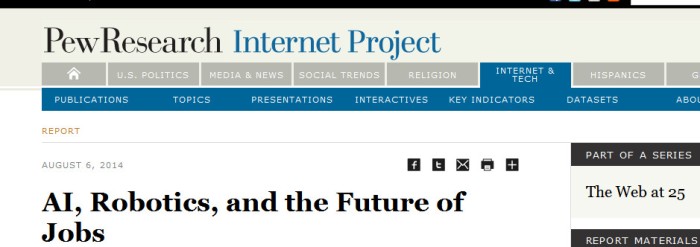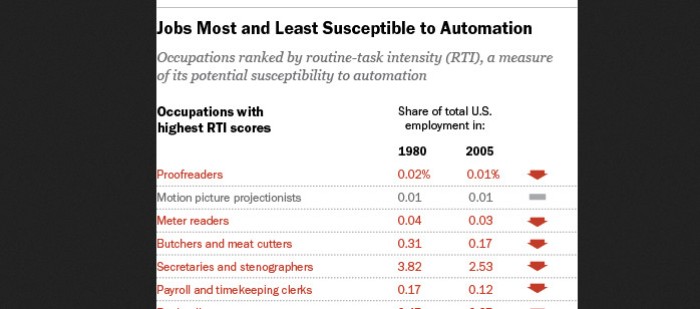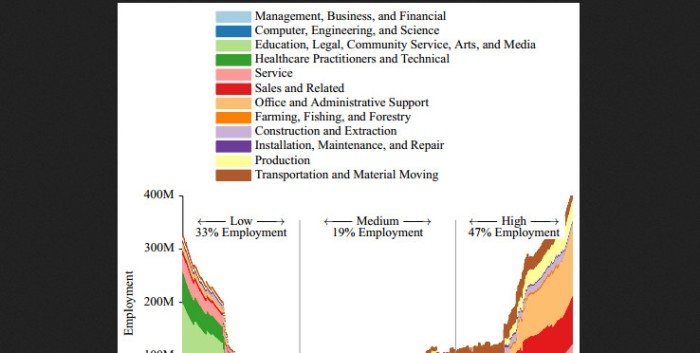Should You Be Worried? These Are the Jobs Robots Will Likely Take Over

Screenshot of the Pew Research Center’s page for the related research (http://www.pewinternet.org/2014/08/06/future-of-jobs/)
If you are still in the process of contemplating on your future career or your employment prospects some years from now, you may want to take a look at the results of a recent research conducted by Pew Research Center. A report has been released listing out the different jobs robots will likely take over. As automation and computer technology advance, employment or careers will doubtlessly be affected. The report released by Pew Research Center on the jobs that will most probably be taken by automation should serve as a warning or as a guide for governments, businesses, and people in general.
Pew Research Center’s report is based on a survey of nearly 1,900 experts. The survey results show how technology has really been advancing and impacting the job market. In the past, there weren’t that many jobs that were expected to be taken away from humans by automation. At present, with computers and systems becoming smarter, more complex jobs that once were thought to be exclusively for humans are now in danger of getting automated. This study anticipates the consequential impact of robotics and artificial intelligence in daily life. However, it is not as scientific as the other studies conducted by Pew Research. It’s more of a canvassing since it is a not a randomized representative survey. The survey approach is an “opt in” type, with the participants getting involved upon invitation, on a voluntary basis.
General Findings
About half (48%) of those surveyed said that robots and digital agents have taken over the employment opportunities for both blue and white collar workers, and will likely worsen the situation of income inequality. A marginally higher number of respondents (52%), however, think that technology will not displace more jobs as it will also create other job opportunities for for those whose jobs have been taken over by machines and artificial intelligence.
The general findings are that advances in technology may let machines take away some human work but will also create new work opportunities. Such a situation calls for the need to adapt to take advantage of the unique human capabilities. As opined by the survey respondents, technology will change the way people look at work in a rather positive and socially beneficial way. These findings may not actually mean anything for most people. That’s why, for something more insightful, it would be better to look at the results of the study conducted on the types of jobs that will likely be taken over by robots or automation.
Routine Task Intensity
To evaluate jobs based on their susceptibility to automation, a benchmark had to be established. This benchmark happens to be RTI or Routine Task Intensity. As the phrase implies, this is a benchmark of how routinary or repetitive a particular job that it can be taken over by machines and artificial intelligence. Obviously, a job that only involves a few steps or procedures tends to be doable for machines since the actions will be predictable and patterns can be established. Needless emphasizing, computers and machines excel at doing repetitive tasks with clear constraints.
The researchers examined the US labor market and ranked them according to their RTI. The rankings are presented below. The jobs ranked don’t include supervisory jobs and residual occupations. The data used to determine respective job market shares are based on the online data files of David Dorn of Centro de Estudios Monetarios y Financieros.

Cropped screenshot of the Pew Research Center’s “Jobs Most and Least Susceptible to Automation” graph (click on the image to go to the pertinent page)
Highest RTI (Highest RTI Jobs Listed First)
- Proofreaders
- Motion picture projectionists
- Meter readers
- Butchers and meat cutters
- Secretaries and stenographers (may include personal assistants)
- Payroll and timekeeping clerks
- Bank tellers
- Barbers
- File clerks
- Boilermakers
- Announcers
- Cashiers
- Typists
- Pharmacists
- Bookkeepers and accounting and auditing clerks
These are the jobs deemed to be more likely to be automated. RTI seems to be a reliable benchmark as the share of these jobs in the overall US job market (with the 1980 vs 2005 figures compared) have been reduced except for the motion picture projectionist, cashier, and pharmacist jobs. Only the cashier job increased from 1.31% to 1.49%. The motion picture projectionist and pharmacist job shares remained the same.
Lowest RTI (Lowest RTI Jobs listed first)
- Athletes, sports instructors and officials
- Firefighters and fire inspectors
- Railroad conductors and yardmasters
- Recreation and fitness workers
- Foresters and Conservation scientists
- Public transportation attendants and inspectors
- Locomotive operators (engineers and firemen in particular)
- Kindergarten and early childhood teachers
- Archivists and curators
- Policemen and detectives
- Primary school teachers
- Surveyors, cartographers, mapping scientists, and technicians
- Actors, directors and producers
- Bus drivers
Except for the surveyors, locomotive operators, foresters and conservation scientists, railroad conductors, and firefighters, the job market shares of these low RTI jobs have increased from 1980 to 2005.

Cropped screenshot of the Pew Research Center’s “Probability of Computerisation” graph (click on the image to go to the pertinent page)
If we look at the details more closely, we can say that the data are not highly accurate but they make strong sense. RTI is a good basis for determining the tendency of a job to become automated but the changes in the job market shares do not fully support the theory that automation and artificial intelligence will display human workers considering that the new jobs that have been created by the advancements in technology are not fully accounted for and included in the comparisons. Hence, the raw data may show automation and computers taking over human jobs but these don’t necessarily contradict the general findings that some jobs for humans are lost to machines but new ones are created to make use of the human abilities that machines still can’t replicate or substitute for.